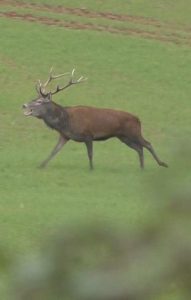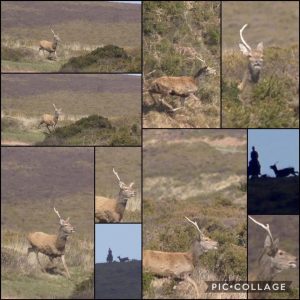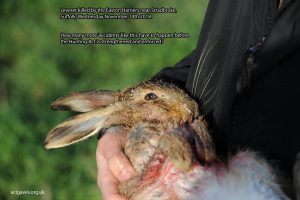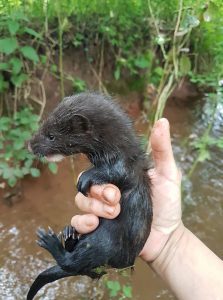We spotted the following information on www.huntingact.org so it saves us writing our own information. We’ve changed the odd word or two, but most of the work must be credited to the authors of that site
Deer Hunting
(photos taken by Somerset Wildlife Crime)
In the UK there are three registered deer hunting packs operating which hunt the red deer. They are located in the south west of England and are the Devon and Somerset Staghounds, the Quantock Staghounds and the Tiverton Staghounds. Before disbanding in 1997 the New Forest Buckhounds hunted the male fallow deer. Roe deer were also hunted by at least two unregistered packs of buckhounds based in the south west of England.
The hunting of red deer is divided into three phases, based on the sex and age of the deer. From the beginning of August to the end of October mature stags are hunted; from November to the beginning of March hinds (females) are hunted and during March and April young stags were hunted. During the stag hunting season the hunt employ a harbourer whose role is to select one or more suitable stags for hunting. He is a local deer expert who would question local residents the day before the hunt about the presence of deer and look out for any evidence of deer such as fresh footprints (“slots”). At dawn on the day of the hunt the harbourer would return to the location and watch the movement of the deer and then inform the huntsman of the deer’s whereabouts once he was satisfied that they would not move too far away from the area. The huntsman would arrive at the location with about ten experienced hounds known as “tufters” which would be used to separate the chosen stag from the rest of the herd. Once the harbourer was satisfied that the correct stag had been separated the whipper-in would collect the rest of the pack, numbering twenty to thirty hounds. The whole pack would then be laid on to the scent or line of the stag, which could be several miles away at this point.
During the hind hunting season a harbourer is not employed to select a particular individual as hinds are almost indistinguishable. Initially the tufters are laid onto a herd of hinds and once a hind had broken away from the main group the rest of the hounds are brought in and the whole pack then laid onto the single hind. Often the hind would have last year’s calf with her. During the days hunting several hinds could be hunted at different times due to the hind merging with a herd and another breaking away.
The length and duration of the hunt could vary considerably. The pursuit could last less than an hour or last all day. On average the overall time of the actual hunt is around 3 hours and the distance 19km. The pursuit of the deer itself consists of intermittent flights; the deer runs away from the hounds at speed, exerting itself maximally until sufficient distance is built up between it and the hounds after which the deer would slow down or even lay down. At this stage the deer could be 3 or 4 km ahead of the hounds. The hounds may lose the scent and cast around to find it again. A series of successive flights may continue until the deer escapes or becomes exhausted. In the latter case the stag would stop running and “stand at bay” where it would turn and face the hounds. Hinds also stop but often hide by laying down in suitable cover. The hounds would surround the deer and bark, but would not kill the deer, although attacks have been known to happen on occasions. The hounds keep the deer at bay until the huntsman and gun carrier arrive to dispatch the deer.
While the deer is focused on the hounds it is approached by a member of the hunt carrying a firearm. Several hunt followers would be carrying firearms and the nearest available gun carrier would shoot the deer, carried out at close quarters by a single shot to the head. In some cases, however, the deer is not killed immediately and moves off wounded. In this instance the hounds re-find the injured deer and bring it to bay so that it can be killed.
The carcass is then taken to an open field either near to or at the meet or to one in the district where the deer was found and where the hunt followers can gather and watch the butchering and sharing out of the carcass, known as the “carve up”. During the carve up various parts of the deer are shared out; the heart is given to the owner of the land where the deer was killed; the liver is cut up and distributed to various supporters of the hunt and the slots and teeth are distributed as trophies. The offal is fed to the hounds and the remaining carcass taken to the kennels where it is butchered. An appointed “venison distributor” would share the meat among the local farmers. The huntsman keeps the skin and the head; if it is a stag the head would be retained by one of the masters and mounted.
Hare Hunting
(photos from ACIGAWIS)
Hare hunting is carried out using several different types of scent hounds: Beagles, Harriers and Basset hounds. Hares are hunted on horseback by Harriers packs and on foot by Beagle and Basset hound packs. The hare hunting season for Harrier packs started at the end of August and ran until March and the hunting season for Beagle packs and Basset hound packs started in September and October respectively and ended in March.
The hunting day began with the gathering of the hunt at the meet which would have been arranged well in advance. The uniform for the huntsman and whipper-in consists of a hunt coat, normally green, white breeches, caps or riding hats, riding boots for Harrier packs or training or hockey shoes for Basset and Beagle packs. The huntsman gives instructions to his whippers-in and other designated followers to position themselves so that hounds could be kept away from roads and from areas where livestock could be disturbed. The huntsman moves off with the hounds to draw for their first hare. Hounds are cast over open ground and several miles may be covered before a hare is found. Finding a hare is dependent on a number of factors including the skill of the huntsman and hounds, the availability of hares and on scenting conditions which was dependent on weather conditions and the type of terrain. Each hound may be seen trying to pick up any small trace of scent or “drag” where a hare might have been feeding; the hounds may initially sight a hare and then hunt her by scent. Alternatively the hare may be seen by one of the whippers-in or followers which would be indicated to the huntsman by raising a hat or arm in the air and pointing in the direction of the hare. The huntsman may then take the hounds over to the signaller where the hounds would pick up the scent.
On poor scenting days the hounds may find it difficult to hold the line for more than a few fields and may hunt slowly before running out of scent. On good scenting days the hounds are able to run fast, holding the scent over several miles. The hunt followers follow at a discreet distance so they do not interfere with the hounds. The hounds are encouraged to hunt with voice and horn calls made by the huntsman.
A description of a typical hare hunt was given by Admiral Sir James Eberle, Chairman of the Association of Masters of Harriers and Beagles (AMHB), in a joint submission to the Burns inquiry in 2000 by the AMHB and the Masters of Basset Hounds Association:
“After a while, the pack will be most likely to lose the scent and will stop and cast themselves around to recover the line. This is known as a ‘check’, for which there are numerous reasons. The hare may have turned sharply, in which case the hounds may have over-run the line. The scent may have failed because the hare has run over freshly manured ground or ground that has been foiled by sheep. The hare may have been ‘headed’ (made to ‘alter course’) by, for instance, running into straying hunt followers or unexpectedly into a herd of cattle. Under such conditions, a hare will lose much of its scent, making it difficult to continue the hunt. if the hounds do not themselves recover the line, the huntsman will try to assist by ‘casting’ the pack in the direction which his experience tells him that the hare may have taken. It also often happens that the hare has stopped and hidden itself (‘clapped’) and must be re-found.
During a cast, which may last five or ten minutes – or even longer if the hare has clapped – it is not unusual that a different hare will get up and hounds will ‘change’. Under these conditions, hounds will be unlikely to catch their original hunted hare. Thus the afternoon’s hunting continues. The normal hunt will involve a number of such ‘checks’. It is only on the few occasions when there is a good scent on clean ground and there is no outside interference, will there be a continuous and unbroken pursuit by hounds, unaided by their huntsman, from ‘find’ to kill’.”
If the hare does not manage to evade the hounds their stamina would outstrip her and as she tires the hounds will eventually catch up and kill her. Hares tend to stick to their own territory and do not venture onto new ground and as a result hare hunting normally takes place in a limited area, of not more than two miles square. While a few straight runs have been known, the hare tends to run in a wide circle. Sometimes runs are fast with almost no checks in which case a hunt lasts no more than thirty minutes or so. More typically, a single hunt, whether ending in a kill or not, could last up to two hours.
Hare Coursing
The object is to test the skills of greyhounds in a competition. Coursing involves a number greyhounds competing against each other, two at a time, in a series of knockout rounds. The dogs are awarded points for their speed and skill in making the hare turn and a point is awarded if the dog catches a hare. Beaters – people using instruments, such as plastic bags, to flush hares from cover – drive hares on to the coursing field one at a time from surrounding fields. The slipper, positioned in a shy, holds two greyhounds on a leash and releases them when the hare is at least 80 yards past the hounds. The hounds would chase the hares, gaining quickly. The hare will try and evade the hounds by turning rapidly. The hounds will sometimes lose the hare if she finds cover. The chase generally only lasts around half a minute. One or more judges assess the skill of the greyhounds and identify the winner of the pair. Hare coursing is not a field trialling activity and is therefore not exempt from the Hunting Act.
Mink Hunting
North American mink were introduced into the UK in 1928 to be farmed for fur and following their release and escape into the wild can be found across most of Britain. The Masters of Mink Hounds Association (MMHA) was formed in 1978 to govern and promote the hunting of mink in the UK after otters became a protected species. Some otter hound packs turned their attention to hunting mink while new packs were formed to hunt mink.
Mink live along the banks of rivers and streams and therefore mink hunting is a river / lake / stream activity. One of the functions of the MMHA is the registration of hunting country. This meant that an individual mink hunt has exclusive use of an area which may comprise a river system, a group of rivers or those rivers within a defined geographical area; nearly all rivers and streams in rural England and Wales are within the registered country of a mink hunt. As a condition of registration with the MMHA each mink hunt has to supply a map of its country to the MMHA so that the boundaries between individual mink hunting countries are known and each mink hunt within such boundaries could operate exclusively within it. On occasions a hunt invites another to meet on a river in its own country. This is known as an “invitation meet”.
Registered mink hunts usually have between 10 and 30 hounds. Most hunts breed their own hounds but also obtain draft hounds from other mink hunting packs and other hunts. In the latter case it is important for a hound which previously hunted fox to transfer its attention to mink, which it soon learns from other pack members. A pack of mink hounds normally consists of a mixture of otter hounds, foxhounds and foxhound crosses.
The mink hunting season runs from April to early October, depending on local water and weather conditions. All hunts hunt at least once a week, normally a Saturday and often on weekday afternoons or evenings. The meet will normally take place at 11.00 am and at a pre-arranged place such as a public house, a farm or a convenient location where cars could be parked. Mink hunting is carried out on foot along a river bank. Initially the huntsman draws along the river bank, trying to pick up the scent of a mink while hunt supporters follow on behind. The huntsman is assisted by whippers-in whose task is to help control the hounds and their hunting activity by stopping them from hunting non-target quarry and keeping them away from such places as roads and railway lines. Also following the hunt would be a terrier man whose role is to use terriers to flush out mink that have gone to ground.
The hounds search the river bank until a mink is found, at which point the hounds start speaking, as in other forms of hunting. Often supporters spot a mink and alert the huntsman of its presence. The mink is hunted by scent along the river bank where it will make maximum use of cover and water. If the hounds lose the scent the huntsman casts backwards and forwards along the river and if unsuccessful then casts both sides of the river, away from the banks, along drainage ditches, tributaries and hedgerows in an attempt to find mink.
Mink have small territories (less than a mile of river bank) and so do not travel far once they are roused. The mink uses its size, agility and swimming ability to evade the hounds, doubling back and retracing its tracks in order to confuse the pursuing pack. Often mink take refuge in holes in the river bank or tree roots whereupon the hunt attempts to flush out the mink using terriers, sticks or spades so that it can be hunted once more. Mink also attempt to escape the hounds by running up trees; in this instance hunt supporters would shake the branches with poles or throw stones to dislodge the mink. If this was not successful the mink would be shot (the MMHA Rules stated that each hunt should have access to a suitable firearm during the days hunting). Once in full swing the hunt would be going up and down the river in a small area chasing the mink from one refuge to another. If the mink is caught it is thrown live to or killed by the hounds, drowned or released to be hunted again. Only occasionally is the mink shot.
A mink hunt could last up to 2 hours once a mink is located, depending on scenting conditions, the ability of the hounds, the terrain and the skill of the huntsman. In some cases a mink may be killed very quickly or “chopped” but more often than not a mink is able to evade the hounds, at least in the first instance.






